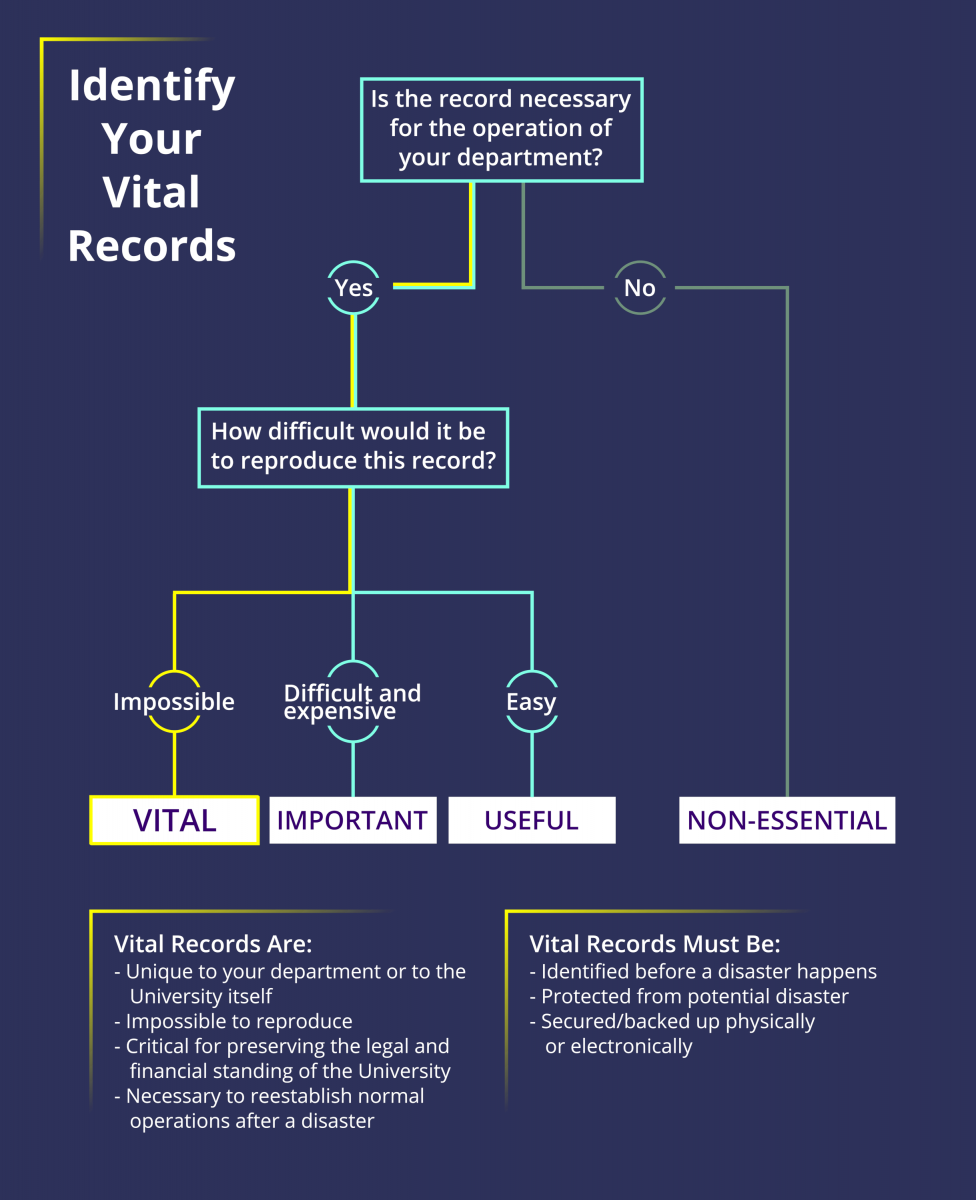Identifying the Vital Records in your office is one of your most critical responsibilities as an employee. It should be performed immediately so that you can arrange for protection prior to a disaster. Only a small percentage (around 5%) of your records will be vital. Most records will fall into one of the following other categories:
- Important Records - These records support the office’s function, and although it may be costly and difficult, CAN be reconstructed or replaced from other sources.
- Useful Records - These records can be easily replaced. The time and cost of reproducing or accessing these records would be minimal because of their ready availability at other locations.
- Non-Essential Records - These records are of little or no value to the mission of the office and which have no compelling reason for having been retained. Examples of non-essential records would be drafts, printouts of electronic records, brochures, publications, etc.

Click to expand
Click here for examples of records that could be vital to the function of your office.
By applying the steps listed below, your office will be able to identify the records that may be necessary to continue office functions after a disaster.
Step 1:
Identify the key functions or responsibilities of your office based on the following criteria:
- Operational - Any functions that are vital to the operation and continuation of your office or the University as a whole.
- Legal - Any functions that provide proof of the University's legal status on an issue.
- Emergency - Any functions needed during an emergency, i.e., telecommunications or emergency rooms.
- Fiscal - Any functions that prove the University's financial standings, i.e. accounts receivable or general ledgers.
Consider:
- The uniqueness of the record
- The relationship of one record to another
- The hardware and applications necessary to access the records
- How soon after the disaster the records will be needed
- How long the records must be retained to meet legal or fiscal requirements (the retention period)
Tools to help you identify the unique functions of your office may include:
- Organization Charts - If these exist in your office, they are a good place to start as they provide a comprehensive list of the functions performed by your office.
- Department Records Retention Schedules - These office-specific retention schedules provide a list of all records that are unique to your office. A departmental retention schedule also allows you determine when a record has reached the end of its lifecycle and should no longer be considered vital.
- Comprehensive Emergency Management Plan for UW - Although the plan primarily addresses emergency personnel (i.e., police, fire department, facility operations), it will help identify what office is responsible for specific functions in the event of an emergency. The plan does provide information regarding the key emergency functions for offices and it promotes determining if any specific responsibilities are listed for your office.
Step 2:
Once you have identified the records which support key functions/responsibilities of your office, answering the following questions will help you to identify your Vital Records. Once you have done this, you may use the Vital Records Checklist (PDF) to make a final decision on which of your records are actually vital.
- What function will we be unable to do if these records are destroyed (i.e., can the work be carried out or continued if this record is gone)?
- How critical (urgent and necessary) is our ability to perform this function?
- What will be the consequences to the University if these records are lost?
- Will any client, employee, or student of the University suffer loss of rights or be inconvenienced if these records are lost?
- Is the record easily accessible during or after a disaster? What if you do not have access to your normal office space? What if you do not have access to your electronic files? Could the University still resume operations?
- Are the records replaceable from another source, such as a duplicate copy or a copy in an online repository? Does another department on campus hold copies of these records?
- If these records have to be reconstructed, what will the cost be in terms of time, money and labor? Will the information in these records have to be reconstructed or retrieved in a matter of hours, days, or weeks?
- Is this the type of information needed during and following a disaster? (Your office’s plan of action in the event of a disaster should always be considered Vital.)